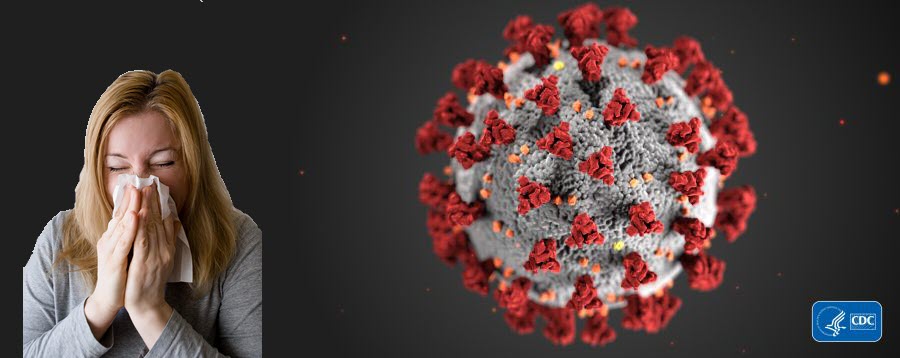
What Business and Employers Need to Know About Coronavirus

On January 30, 2020, the International Health Regulations Emergency Committee of the World Health Organization declared the coronavirus disease 2019 (COVID-19) outbreak a “public health emergency of international concern.” The next day, Health and Human Services declared a public health emergency for the United States to aid the nation’s healthcare community in responding to COVID-19.
How Does COVID-19 Spread?
The route of transmission has not been completely identified, but the virus is thought to spread mainly from person-to-person. This occurs between people who are in close contact with one another (within about 6 feet), or through respiratory droplets produced when an infected person coughs or sneezes. It’s possible the virus can spread via contact with infected surfaces or objects, but this is not thought to be the main way the virus spreads.
Person-to-person spread has been reported in many countries, including the United States. Some international destinations now have apparent community spread with the virus that causes COVID-19, meaning some infected people are not sure how or where they became infected.
What is a Coronavirus?
Coronaviruses (CoV) are a large family of viruses that are common and are typically associated with mild illnesses, similar to the common cold. COVID-19 presents with fever and symptoms of lower respiratory illness (e.g., cough or difficulty breathing). Fever may not be present in all patients. Most people who become infected experience mild illness and recover, but it can be more severe for others. Reported COVID-19 illnesses have ranged from mild symptoms to severe illness and death.
People of all ages can be infected. Older people, and people with pre-existing medical conditions (such as asthma, diabetes, heart disease) appear to be more vulnerable to becoming severely ill with the virus.
Coronavirus spreads when an infected person coughs or sneezes. Reminding people to cover coughs helps create a healthy workplace.
To Avoid Getting Sick – Wash Your Hands
The #1 recommendation from the World Health Organization to prevent transmission of a coronavirus is to frequently wash your hands. Although this seems simple, there are “right” and “wrong” ways to wash hands effectively. Using enough soap to produce lather and scrubbing thoroughly for at least 20 seconds are two key steps that are often missed. Handwashing instruction signs that show proper hand washing technique can help stop the spread of harmful germs.
At this time, there is no vaccine to protect against COVID-19 and no medications approved to treat it. Although sales of surgical face masks have soared during this outbreak, masks are not necessary for most people. The WHO advises:
- If you are healthy, you only need to wear a mask if you are taking care of a person with suspected infection.
- Wear a mask if you are coughing or sneezing.
- Masks are effective only when used in combination with frequent hand-cleaning with alcohol-based hand rub or soap and water.
- If you wear a mask, then you must know how to use it and dispose of it properly.
Handwashing is the #1 way to stop the spread of disease. Post signs like this to show proper handwashing technique.
What is the Current Risk?
The CDC offers this current risk assessment:
- For the general American public, who are unlikely to be exposed to this virus at this time, the immediate health risk from COVID-19 is considered low.
- People in communities where ongoing community spread with the virus that causes COVID-19 has been reported are at elevated though still relatively low risk of exposure.
- Healthcare workers caring for patients with COVID-19 are at elevated risk of exposure.
- Close contacts of persons with COVID-19 also are at elevated risk of exposure.
- Travelers returning from affected international locations where community spread is occurring also are at elevated risk of exposure.
Children need to learn effective handwashing techniques to help prevent the spread of diseases including coronavirus.
What May Happen
The CDC says more cases of COVID-19 are likely to be identified in the coming days, including more cases in the United States. It’s also likely that person-to-person spread will continue and eventually widespread transmission of COVID-19 in the United States will occur.
Widespread transmission would result in large numbers of people needing medical care at the same time. Schools, childcare centers, workplaces and facilities for mass gatherings may experience increased absenteeism. Public health and healthcare systems, emergency medical services and the transportation industry may also be affected.
Coronavirus Guidance for Businesses and Employers
The Centers for Disease Control and Prevention (CDC) has posted guidance for businesses and employers regarding Coronavirus Disease (COVID-19). It includes recommended strategies for employers to use now, advice on planning for a possible U.S. outbreak and resources for more information.
Coronavirus and Flu Resources:
- Advice for Businesses
- Workplace safety and discrimination concerns.
- Info for Healthcare Facilities
- Advice for Schools and Childcare Providers
- Resources for Testing Labs
- Workplace Safety and the Flu – How To Protect Workers
- Latest Updates from the World Health Organization
- Browse Coronavirus-related Signs and Labels for your School or Workplace

